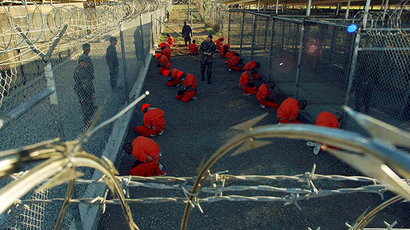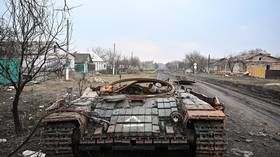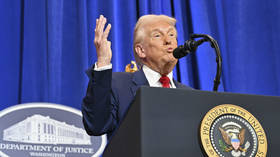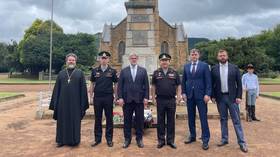‘They caused problems’: CIA involved with Gitmo inmates’ suicides – former guard to RT
A former Guantanamo guard, who says he witnessed hunger strike “leaders” being brought to a secret CIA “black site”, is accusing the agency of having staged their suicide to get rid of the “problem”. At the time, the US said the men hanged themselves.
On June 10, 2006, the Department of Defense reported that Saudi Arabians Mani al-Utaybi and Yasser al-Zahrani, and a Yemeni citizen, Ali Abdullah Ahmed, “killed themselves in an apparent suicide pact.”
“Two Saudis and one Yemeni, each located in Camp 1, were found unresponsive and not breathing in their cells by guards,” Joint Task Force-Guantanamo said at that time, adding that “all lifesaving measures had been exhausted.”
The following day, the camp quickly went into lockdown.
Contrary to the official statement, unsubstantiated reports started to surface, accusing the Bush administration of hiding the truth behind what was described as a “planned event”.
Nearly 10 years on, former Guantanamo guard Joseph Hickman is stepping forward to unveil what he saw in the few hours leading up to the secretive deaths. Speaking to RT, Hickman shared why he thinks that the US government might have had an interest in silencing the prisoners who “caused a lot of problems for the command” of Guantanamo Bay.
‘CIA Black site’
“At around 5:30pm and 6:00pm on June 9, I went to the tower guards – I was visiting them to see how they were going to perform their duties that night,” the former sergeant of the guard recalled.
While there, Hickman noticed what he thought was an unusually suspicious commotion for a Friday evening.
“I witnessed a van – we used to call it paddy wagon – it was a detainee transport van,” he said. “The van came into the gate, backed up to Camp 1 and took a detainee out of Camp 1 Alpha Block and put him into the paddy wagon and drove [him away].”
US government fights to keep ‘disturbing’ force-feeding Gitmo footage secret https://t.co/S13o5Shfktpic.twitter.com/7zoHaxPQ6a
— RT (@RT_com) January 22, 2016
This happened two more times, in time periods of approximately 20 minutes apart, meaning that there were “a total of three out of Camp 1 Alpha Block.”
“I got suspicious because there was no military commissions going on, they were taking detainees outside of Camp America,” Hickman said. Camp America is where all detainee holding facilities are located, “I was suspicious of why they were doing it and where they were going.”
He still has a strong recollection of the route the van was taking and can repeat it turn-by-turn.
“If it went straight on the road leaving Camp America, it would be going to the main part of the base, where Navy Exchange [the store on the base] was, but about 100 meters past the checkpoint ACP Roosevelt, there was a turn,” the former Guantanamo guard recalls.
“If they made that turn, then the paddy wagon was going to a facility which we called Camp No, which is a CIA black site on Guantanamo at the time,” Hickman claims.
The wagon did not go to the main base, but instead “it went to the left.”
“There are only two things when you make that left, the CIA black site which is hidden back in the hills, behind heavy terrain, or it would lead to the beach if you went further,” Hickaman said. “So, it certainly was not going [to the beach]. The only other place it could have been going was the CIA black site.”
‘They caused a lot of problems’
At the time, the JTF command had been interrogating roughly 200 prisoners per week, according to Hickman. However, detainees made it tough as Washington-approved Guantanamo interrogation policies have prohibited questioning of hunger-striking inmates.
Raising up to fight for their innocence and protest the conditions of their confinement, detainees held long-term hunger strikes, starting in 2005.
“All three of those detainees that went to that CIA Black Site that night were all leaders of the hunger strikes, massive hunger strikes,” Hickman said. “There were constant hunger strikes since they arrived. They caused a lot of problems for the command.”
Guantanamo prisoner held for 13 years on mistaken identity cleared for release https://t.co/5p24OlLJtDpic.twitter.com/OhuJbYiDCP
— RT (@RT_com) January 22, 2016
He even contemplates that the Guantanamo Bay command would do whatever it takes to stop hunger strikers.
“Even [Yasser] Al Zahrani, one of the detainees who died that evening, wrote in a letter to his father, I think it was his last letter, camp command wants to get rid of me at any cost,” Hickman said.
Under the Pentagon’s official version, Al-Zahrani was the first of the three found in his cell, followed by Al-Utaybi and Al-Salami.
According to the US Naval Criminal Investigative Service, all three were preparing the suicide. As the NCIS report claimed they hanged themselves on torn sheets and T-shirts, while their hands were tied.
However, the fact of precise planning Hickman also dismisses.
“Many detainees, they were on the same cell block that night, also have said that no one hung themselves that night, where the government said they saw them. Nothing like that,” he said.
#Gitmo designed to ‘destroy human beings’: Ex-inmate Shaker #Aamer talks to RT https://t.co/AT7VfXvSWWpic.twitter.com/fLxaCv6mPn
— RT (@RT_com) January 12, 2016
Hickman believes that Shaker Aamer, who was imprisoned in 2002, could have also been among the CIA’s victims. He claims that deadly night of June 9, Aamer was “brutally tortured.”
“I believe the only thing why they kept Shaker alive was his British residency,” he said.
‘Justice Department squashed my story’
Upon leaving Guantanamo, Hickman decided to take his concerns to the government. However, the step did not have a desired effect.
“I went to the Justice Department once. Basically, they squashed the story because I was revealing the CIA Black Site and they did not want that information out,” he said.
In February 2010, Scott Horton, a human rights attorney, for the first time unveiled a cover-up surrounding the suspicious deaths and “Camp No”, as Hickman dubbed it.
Horton’s lengthy report in Harper’s Magazine, made the full extent of Hickman’s story known to the world.
Yet, the revelations failed to bring a change. Six years after the publication, Hickman keeps pushing the issue. He has written a book, "Murder at Camp Delta" detailing the events that he saw, the concerns he had. Out in paperback starting February 23, Murder at Camp Delta is already available on Amazon.
“After those three deaths, there were two other detainees that committed suicide,” he told RT. “I wasn’t there to say exactly what happened, but I knew from my experience: Those men did not commit a suicide. It brought up questions, which brought up nightmares. It just hunted me until I came forward.”














